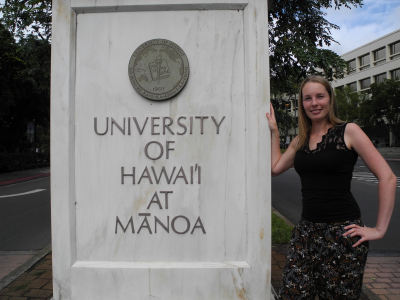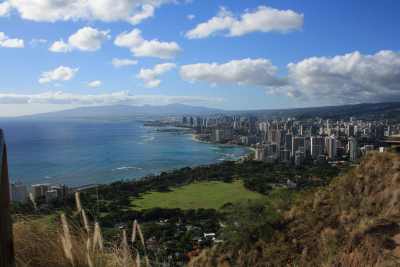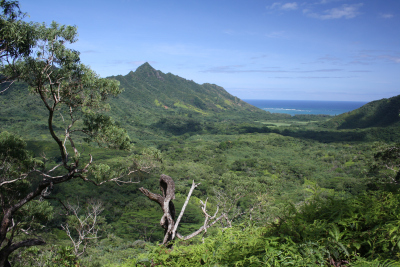Die Inhalte dieser Seite sind leider nicht auf Deutsch verfügbar.
Seitenpfad:
Kim Vane
Report of GLOMAR PhD student Kim Vane about her research stay at the University of Hawai’i at Mānoa, O’ahu, Hawai’i from 30 September to 2 December 2016
My PhD thesis revolves around the use of chemical tracers incorporated in fish otoliths to reconstruct their migration and resource use. As these chemical tracers, that originate from the aquatic environment, are incorporated into the otolith throughout the life of the fish, the otolith represents a lifelong movement record of individual fish. Such information can be used for fisheries management and conservation of that particular species.
In my PhD I obtain this information by using a specialized analysis of compound specific isotope analysis of δ13C in amino acids. However, amino acids can also be analysed for δ15N and gives information on which position an organism occupies in the food chain. This δ15N analysis requires a slightly different set up of machinery and expertise relative to δ13C analysis, which we do not have in our laboratory. This 2-month research stay thus allowed me to experience the analysis of δ15N in amino acids in the very experienced stable isotope laboratory of Prof. Brian Popp at the University of Hawai’i. Utilizing a different methodology and personally using the machinery significantly broadened my insight and experience in this analytical field. Such insight is very valuable to understand what the main analytical issues are and how you treat the data accordingly. I also learned much from seeing a different laboratory routine and the detailed knowledge this lab has gained on this analysis over a long time.
My second aim of this research stay was to try the δ15N in amino acids analysis on my PhD focus, the fish otoliths. This had not been attempted before due to the large sample amount requirements, which is a complication for often small otoliths. Nevertheless, I was quite curious to see if it could work on particularly large otoliths from which it is relatively easier to obtain large amount of material for analysis. With some trial and error in the process, we could show for the first time that this is indeed possible. These results will be a part of my PhD thesis and provides valuable information on the trophic position of the commercial fish in Brazil to which the otoliths belong.
I would like to thank GLOMAR for the financial support that allowed me to gain invaluable experience that will help me throughout my scientific career. Also, many thanks to Prof. Brian Popp and Dr. Natalie Wallsgrove that gave me the opportunity to expand my knowledge on CSIA with their longstanding experience and support for an experimental approach.
In my PhD I obtain this information by using a specialized analysis of compound specific isotope analysis of δ13C in amino acids. However, amino acids can also be analysed for δ15N and gives information on which position an organism occupies in the food chain. This δ15N analysis requires a slightly different set up of machinery and expertise relative to δ13C analysis, which we do not have in our laboratory. This 2-month research stay thus allowed me to experience the analysis of δ15N in amino acids in the very experienced stable isotope laboratory of Prof. Brian Popp at the University of Hawai’i. Utilizing a different methodology and personally using the machinery significantly broadened my insight and experience in this analytical field. Such insight is very valuable to understand what the main analytical issues are and how you treat the data accordingly. I also learned much from seeing a different laboratory routine and the detailed knowledge this lab has gained on this analysis over a long time.
My second aim of this research stay was to try the δ15N in amino acids analysis on my PhD focus, the fish otoliths. This had not been attempted before due to the large sample amount requirements, which is a complication for often small otoliths. Nevertheless, I was quite curious to see if it could work on particularly large otoliths from which it is relatively easier to obtain large amount of material for analysis. With some trial and error in the process, we could show for the first time that this is indeed possible. These results will be a part of my PhD thesis and provides valuable information on the trophic position of the commercial fish in Brazil to which the otoliths belong.
I would like to thank GLOMAR for the financial support that allowed me to gain invaluable experience that will help me throughout my scientific career. Also, many thanks to Prof. Brian Popp and Dr. Natalie Wallsgrove that gave me the opportunity to expand my knowledge on CSIA with their longstanding experience and support for an experimental approach.





